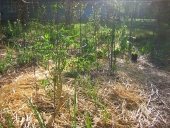








 1
1




"You must be the change you want to see in the world." "First they ignore you, then they laugh at you, then they fight you, then you win." --Mahatma Gandhi
"Preach the Gospel always, and if necessary, use words." --Francis of Assisi.
"Family farms work when the whole family works the farm." -- Adam Klaus
 2
2








Ajila Ama Farm Western North Carolina
www.facebook.com/ajilaama
 2
2




Ajila Ama Farm Western North Carolina
www.facebook.com/ajilaama




R Scott wrote:You can make a man-sized crimp roller out of a lawn roller and strap iron ($200-300 new, under 100 from CL).
 1
1




http://www.breezymeadowsorchards.com/learn/permaculture-design-course
Breezy Meadows orchard & Nursery Permaculture Design Course. Join us at our permaculture farm in the wilds of Tinmouth, VT. Hands on experience on a working farm that produces food 365 days a year.




"You must be the change you want to see in the world." "First they ignore you, then they laugh at you, then they fight you, then you win." --Mahatma Gandhi
"Preach the Gospel always, and if necessary, use words." --Francis of Assisi.
"Family farms work when the whole family works the farm." -- Adam Klaus




Be most excellent to each other.




 1
1





"You must be the change you want to see in the world." "First they ignore you, then they laugh at you, then they fight you, then you win." --Mahatma Gandhi
"Preach the Gospel always, and if necessary, use words." --Francis of Assisi.
"Family farms work when the whole family works the farm." -- Adam Klaus
 2
2




"We have it in our power to begin the world over again." - Thomas Paine
 1
1




"You must be the change you want to see in the world." "First they ignore you, then they laugh at you, then they fight you, then you win." --Mahatma Gandhi
"Preach the Gospel always, and if necessary, use words." --Francis of Assisi.
"Family farms work when the whole family works the farm." -- Adam Klaus












Jess DeMoss wrote:Would there be specific cover crop plants that would lend themselves better to being cut than bent?
 1
1





Willing to find out what 'impossible' means.




Regards, Scott
 1
1








Regards, Scott





|
I'm so happy! And I wish to make this tiny ad happy too:
Free Seed Starting ebook!
https://permies.com/t/274152/Orta-Guide-Seed-Starting-Free
|








